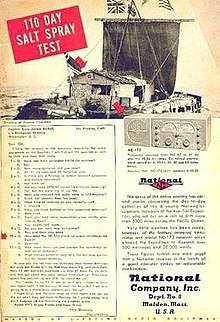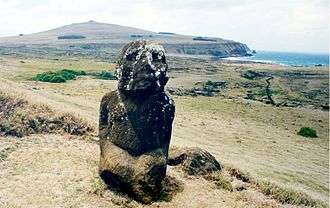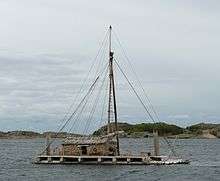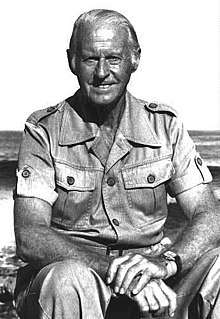Kon-Tiki expedition
The Kon-Tiki expedition was a 1947 journey by raft across the Pacific Ocean from South America to the Polynesian islands, led by Norwegian explorer and writer Thor Heyerdahl. The raft was named Kon-Tiki after the Inca god Viracocha, for whom "Kon-Tiki" was said to be an old name. Kon-Tiki is also the name of Heyerdahl's book, the Academy Award-winning 1950 documentary film chronicling his adventures, and the 2012 dramatized feature film nominated for the Academy Award for Best Foreign Language Film.
Heyerdahl believed that people from South America could have reached Polynesia during pre-Columbian times. His aim in mounting the Kon-Tiki expedition was to show, by using only the materials and technologies available to those people at the time, that there were no technical reasons to prevent them from having done so. Although the expedition carried some modern equipment, such as a radio, watches, charts, sextant, and metal knives, Heyerdahl argued they were incidental to the purpose of proving that the raft itself could make the journey.
The Kon-Tiki expedition was funded by private loans, along with donations of equipment from the United States Army. Heyerdahl and a small team went to Peru, where, with the help of dockyard facilities provided by the Peruvian authorities, they constructed the raft out of balsa logs and other native materials in an indigenous style as recorded in illustrations by Spanish conquistadores. The trip began on April 28, 1947. Heyerdahl and five companions sailed the raft for 101 days over 6,900 km (4,300 miles) across the Pacific Ocean before smashing into a reef at Raroia in the Tuamotus on August 7, 1947. The crew made successful landfall and all returned safely.
Thor Heyerdahl's book about his experience became a bestseller. It was published in Norwegian in 1948 as The Kon-Tiki Expedition: By Raft Across the South Seas, later reprinted as Kon-Tiki: Across the Pacific in a Raft. It appeared with great success in English in 1950, also in many other languages. A documentary motion picture about the expedition, also called Kon-Tiki, was produced from a write-up and expansion of the crew's filmstrip notes and won an Academy Award in 1951. It was directed by Heyerdahl and edited by Olle Nordemar. The voyage was also chronicled in the documentary TV-series The Kon-Tiki Man: The Life and Adventures of Thor Heyerdahl, directed by Bengt Jonson.[1]
The original Kon-Tiki raft is now on display in the Kon-Tiki Museum at Bygdøy in Oslo.
Crew
Kon-Tiki had a six-man crew, all of whom were Norwegian except for Bengt Danielsson, a Swede.[2]
- Thor Heyerdahl (1914–2002) was the expedition leader. He was also the author of the book of the expedition and the narrator of the story. Heyerdahl had studied the ancient people of South America and Polynesia and believed that there was a link between the two.
- Erik Hesselberg (1914–1972) was the navigator and artist. He painted the large Kon-Tiki figure on the raft's sail. His children's book Kon-Tiki and I appeared in Norwegian in 1949 and has since been published in more than 15 languages.
- Bengt Danielsson (1921–1997) took on the role of steward, in charge of supplies and daily rations. Danielsson was a Swedish sociologist interested in human migration theory. He also served as translator, as he was the only member of the crew who spoke Spanish. He was also a voracious reader; his box aboard the raft contained many books.
- Knut Haugland (1917–2009) was a radio expert, decorated by the British in World War II for actions in the Norwegian heavy water sabotage that stalled what were believed to be Germany's plans to develop an atomic bomb. Haugland was the last surviving crew member; he died on Christmas Day, 2009 at the age of 92.[3]
- Torstein Raaby (1918–1964) was also in charge of radio transmissions. He gained radio experience while hiding behind German lines during WWII, spying on the German battleship Tirpitz. His secret radio transmissions eventually helped guide in Allied bombers to sink the ship.
- Herman Watzinger (1910–1986) was an engineer whose area of expertise was in technical measurements. He was the first to join Heyerdahl for the trip. He collected and recorded all sorts of data on the voyage. Much of what he recorded, such as weather data, was sent back to various people, since this area of the ocean was largely unstudied.
The expedition also carried a pet parrot named Lorita.
Construction
The main body of the float was composed of nine balsa tree trunks up to 14 m (45 ft) long, 60 cm (2 ft) in diameter, lashed together with 30 mm (1 1⁄4 in) hemp ropes. Cross-pieces of balsa logs 5.5 m (18 ft) long and 30 cm (1 ft) in diameter were lashed across the logs at 91 cm (3 ft) intervals to give lateral support. Pine splashboards clad the bow, and lengths of pine 25 mm (1 in) thick and 60 cm (2 ft) wide were wedged between the balsa logs and used as centreboards.
The main mast was made of lengths of mangrove wood lashed together to form an A-frame 8.8 m (29 ft) high. Behind the main-mast was a cabin of plaited bamboo 4.3 m (14 ft) long and 2.4 m (8 ft) wide was built about 1.2–1.5 m (4–5 ft) high, and roofed with banana leaf thatch. At the stern was a 5.8 m (19 ft) long steering oar of mangrove wood, with a blade of fir. The main sail was 4.6 by 5.5 m (15 by 18 ft) on a yard of bamboo stems lashed together. Photographs also show a top-sail above the main sail, and also a mizzen-sail, mounted at the stern.
The raft was partially decked in split bamboo.[4] The main spars were a laminate of wood and reeds and Heyerdahl tested more than twenty different composites before settling on one that proved an effective compromise between bulk and torsional rigidity. No metal was used in the construction.
Supplies
Kon-Tiki carried 1,040 litres (275 US gal) of drinking water in 56 water cans, as well as a number of sealed bamboo rods. The purpose stated by Heyerdahl for carrying modern and ancient containers was to test the effectiveness of ancient water storage. For food Kon-Tiki carried 200 coconuts, sweet potatoes, bottle gourds and other assorted fruit and roots. The U.S. Army Quartermaster Corps provided field rations, tinned food and survival equipment. In return, the Kon-Tiki explorers reported on the quality and utility of the provisions. They also caught plentiful numbers of fish, particularly flying fish, "dolphin fish", yellowfin tuna, bonito and shark.
Heyerdahl and crew were equipped with water-tight sports wristwatches manufactured by Swiss watchmaking firm Eterna.[5] After the journey, Eterna decided to brand their sports watches as "Kon-Tiki".[6]
Communications

The expedition carried an amateur radio station with the call sign of LI2B operated by former World War II Norwegian resistance radio operators Knut Haugland and Torstein Raaby.[7] Haugland and Raaby maintained regular communication with a number of American, Canadian, and South American stations that relayed Kon Tiki's status to the Norwegian Embassy in Washington, D.C. On August 5, Haugland made contact with a station in Oslo, Norway, 16,000 kilometres (10,000 mi) away.[8][9]
Kon Tiki's transmitters were powered by batteries and a hand-cranked generator and operated on the 40, 20, 10, and 6-meter bands. Each unit was water resistant, used 2E30 vacuum tubes, and provided approximately 6 watts of RF output; the equivalent of a small flashlight.[10] Two British 3-16 MHz Mark II transmitters were also carried on board, as was a VHF transmitter for communicating with aircraft and a hand-cranked survival radio of the Gibson Girl type for 500 and 8280 kHz.[7]
The radio receiver used throughout the voyage, a National Radio Company NC-173, once required a thorough drying out after being soaked when landing in Raratonga.[11] The crew once used a hand-cranked emergency transmitter to send out an "all well, all well" message "just in time to head off a massive rescue attempt".[12]
The call sign LI2B was used by Heyerdahl again in 1969–70, when he built a papyrus reed raft and sailed from Morocco to Barbados in an attempt to show a possible link between the civilization of ancient Egypt and the New World.[13]
The voyage
Kon-Tiki left Callao, Peru, on the afternoon of April 28, 1947. To avoid coastal traffic it was initially towed 80 km (50 mi) out by the Peruvian Navy fleet tug Guardian Rios, then sailed roughly west carried along on the Humboldt Current.[14]
The crew's first sight of land was the atoll of Puka-Puka on July 30. On August 4, the 97th day after departure, Kon-Tiki reached the Angatau atoll. The crew made brief contact with the inhabitants of Angatau Island, but were unable to land safely. Calculations made by Heyerdahl before the trip had indicated that 97 days was the minimum amount of time required to reach the Tuamotus, so the encounter with Angatau showed that they had made good time.
On August 7, the voyage came to an end when the raft struck a reef and was eventually beached on an uninhabited islet off Raroia atoll in the Tuamotus. The team had travelled a distance of around 6,980 km (4,340 mi; 3,770 nmi) in 101 days, at an average speed of 1.5 knots (2.8 km/h; 1.7 mph).
After spending a number of days alone on the tiny islet, the crew was greeted by men from a village on a nearby island who arrived in canoes, having seen washed-up flotsam from the raft. The crew were taken back to the native village, where they were feted with traditional dances and other festivities. Finally the crew were taken off Raroia to Tahiti by the French schooner Tamara, with the salvaged Kon-Tiki in tow.
Anthropology

Heyerdahl believed that the original inhabitants of Easter Island were migrants from Peru. He argued that the monumental statues known as moai resembled sculptures more typical of pre-Columbian Peru than any Polynesian designs. He believed that the Easter Island myth of a power struggle between two peoples called the Hanau epe and Hanau momoko was a memory of conflicts between the original inhabitants of the island and a later wave of Native Americans from the Northwest coast, eventually leading to the annihilation of the Hanau epe and the destruction of the island's culture and once-prosperous economy.[15][16]
Most historians consider that the Polynesians from the west were the original inhabitants and that the story of the Hanau epe is either pure myth, or a memory of internal tribal or class conflicts.[17][18][19] In 2011, Professor Erik Thorsby of the University of Oslo presented DNA evidence to the Royal Society which, whilst agreeing with the west origin, also identified a distinctive but smaller genetic contribution from South America.[20]
This result was questioned in 2012 because of the possibility of contamination by South Americans after European contact with the islands.[21] In 2014, further work by a team including Anna-Sapfo Malaspinas (from the Natural History Museum of Denmark) analysed the genomes of 27 native Rapa Nui people and found that their DNA was on average 76 percent Polynesian, 8 percent Native American and 16 percent European. Analysis showed that "although the European lineage could be explained by contact with white Europeans after the island was 'discovered' in 1722 by Dutch sailors, the South American component was much older, dating to between about 1280 and 1495, soon after the island was first colonised by Polynesians in around 1200."[22]
Genetic analysis of Polynesians and Native South Americans, published in Nature in July 2020, has revealed that several eastern Polynesian populations have signs of an ancient genetic signature that originated from Native South American people. An initial admixture event between Native South Americans and Polynesians, discovered by statistical analysis, took place around AD 1150–1230.[23][24]
Later recreations of Kon-Tiki
Seven Little Sisters
In 1954, William Willis sailed alone on a raft Seven Little Sisters from Peru to American Samoa, successfully completing the journey.[25] He sailed 10,800 km (6,700 mi), which was 3,500 km (2,200 mi) farther than Kon-Tiki. In a second great voyage ten years later, he rafted 12,001 km (7,457 mi) from South America to Australia with a metal raft Age Unlimited.
Kantuta
In 1955, the Czech explorer and adventurer Eduard Ingris attempted to recreate the Kon-Tiki expedition on a balsa raft called Kantuta. His first expedition, Kantuta I, took place in 1955–1956 and led to failure. In 1959, Ingris built a new balsa raft, Kantuta II, and tried to repeat the previous expedition. The second expedition was a success. Ingris was able to cross the Pacific Ocean on the balsa raft from Peru to Polynesia.
Tahiti-Nui
A French seafarer, Éric de Bisschop, committed himself in a project he had had for some years: he built a Polynesian raft in order to cross the eastern Pacific Ocean from Tahiti to Chile (contrary to Thor Heyerdahl's crossing); the Tahiti-Nui left Papeete with a crew of five on November 8, 1956. When near the Juan Fernández Islands (Chile) in May 1957, the raft was in a very poor state and they asked for a towing, but it was damaged during the operation and had to be abandoned, but they were able to preserve all the equipment that had been aboard.
Tahiti-Nui II
A second Tahiti-Nui was built in Constitución, Chile, leaving on April 13, 1958, towards Callao, then towards the Marquesas. It missed its target and after four months, the raft began to sink. The crew built a new smaller raft, the Tahiti Nui III, in the ocean out of the more buoyant parts of the Tahiti Nui II.[26] They were swept towards Cook Islands where on August 30, the raft went aground and was wrecked at Rakahanga atoll. Éric de Bisschop died in this accident.
Tangaroa
A Peruvian expedition led by Carlos Caravedo crossed the Pacific Ocean in 1965 in 115 days in a raft named Tangaroa, of which 18 days were used by the crew to cross Tuamotus, the Tuamotu Archipielago, making Tangaroa the only raft that has managed to cross that dangerous archipelago of French Polynesia by its own means. On November 18, 1965, the Tangaroa ended its journey on the Fakarava island. Fakarava is where the Tangaroa is currently preserved.
Las Balsas
The 1973 Las Balsas expedition was the first (and so far only) multiple-raft crossing of the Pacific Ocean in recent history. It is the longest-known raft voyage in history. The expedition was led by Spaniard Vital Alsar, who, in 1970, led the La Balsa expedition, only on that occasion with one raft and three companions. The crossing was successful and, at the time, the longest raft voyage in history, until eclipsed in 1973 by Las Balsas. The purpose of the 1973 expedition was three-fold: (1) to prove that the success of 1970 was no accident, (2) to test different currents in the sea, which Alsar maintained ancient mariners knew as modern humans know road maps, and (3) to show that the original expeditions, directed perhaps toward trade or colonisation, may have consisted of small fleets of balsa rafts.
Tangaroa

In 2006, the Tangaroa Expedition recreated the Kon-Tiki voyage using a newly built raft, the Tangaroa, named after the Māori sea-god Tangaroa. Tangaroa's six-man crew was led by Norwegian Torgeir Higraff and included Olav Heyerdahl, grandson of Thor Heyerdahl, Bjarne Krekvik (captain), Øyvin Lauten (executive officer), Swedish Anders Berg (photographer) and Peruvian Roberto Sala.[27] Tangaroa was launched on the same day that Kon-Tiki had been—April 28—and it reached its destination on July 7, which was 30 days faster than Heyerdahl's Kon-Tiki which had taken 101 days for the voyage. Tangaroa's speed was credited to the proper use of guaras (centerboards).
An-Tiki
On January 30, 2011, An-Tiki, a raft modeled after Kon-Tiki, began a 4,800-kilometre (3,000 mi), 70-day journey across the Atlantic Ocean from the Canary Islands to the island of Eleuthera in the Bahamas.[28] The expedition was piloted by four men, aged from 56 to 84 years, led by Anthony Smith.[29] The trip was designed to commemorate the journey in an open boat of survivors from the British steamship Anglo-Saxon, sunk by the German cruiser Widder in 1940. The raft ended its voyage in the Caribbean island of St Maarten, completing its trip to Eleuthera in the following year with Smith and a new crew.[30][31]
Kon-Tiki2
On 7 November 2015, two teams with two balsa rafts Rahiti Tane and Tupac Yupanqui left Lima, Peru for Easter Island. Expedition Kon-Tiki2 got its name because it had 2 crews from many nations: Norway, Russia, UK, Mexico, New Zealand, Sweden, and Peru. It sought to double down on Heyerdahl's voyage by sailing two rafts from South America to Polynesia and then back. Expedition leader was Torgeir Higraff from Tangaroa Expedition (2006). Øyvin Lauten and Kari Skår Dahl were captains on the first leg, while Signe Meling and Ola Borgfjord were captains on the second leg. The raft reached Easter Island, but did not complete the return.
The two rafts were made of 11 balsa logs and 10 crossbeams held together by 2000 meters of natural fiber ropes. Tens of thousands of waves, up to six meters tall, hit the rafts in an El Niño year. This stress for 16 weeks weakened the ropes, but the crew could not replace all of them.[32][33][34] On March 3, 2016, all crew members were taken on board the Hokuetsu Ushaka freight ship after 115 days of sailing and 4½ months at sea.
Documentation
Memoir book
A book documenting the voyage and raft was released in 1948 by Thor Heyerdahl, called The Kon-Tiki Expedition: By Raft Across the South Seas.[35]
Fictionalization
Kon-Tiki is a 2012 Norwegian historical dramatized feature film about the 1947 Kon-Tiki expedition. It stars Pål Sverre Valheim Hagen as Thor Heyerdahl and is directed by Joachim Rønning and Espen Sandberg. It was the highest-grossing film of 2012 in Norway and the country's most expensive production to date.
Episode 5 of the tenth season of HBO's Curb Your Enthusiasm cable television show features Clive Owen as himself in a one man play entitled "Kon Tiki".
See also
References
- The Kon-Tiki Man episode breakdown Archived October 28, 2007, at the Wayback Machine
- Thor Heyerdahl, Thor (1968). The Kon-Tiki Expedition. Rand McNally. Retrieved 5 April 2012.
- Alter, Bonnie (December 30, 2009). "Last Crew Member on Kon-Tiki Expedition Dies". TreeHugger. Retrieved December 16, 2018.
- Heyerdahl, Thor (1984). Kon-Tiki: across the Pacific by raft. Rand McNally. p. 63. Retrieved 5 April 2012.
- "Eterna celebrates 160 years". fhs.swiss. Federation of the Swiss Watch Industry FH. Retrieved 3 June 2020.
In 1947, young archaeologist and ethnologist Thor Heyerdahl is searching for appropriate watches for a particularly bold oceanic expedition. Dr. Schild-Comtesse decides to help the Norwegian...Eterna undertakes the production of a small series of wrist watches which are particularly water-tight and resistant. It is these very watches which accompany Thor Heyerdahl and his crew made up of five other scientists during their journey on board a balsa raft christened KonTiki.
- Reyne Haines (10 February 2011). Warman's Watches Field Guide. Penguin Publishing Group. pp. 100–. ISBN 978-1-4402-1886-6.
In 1947, Thor Heyerdahl wore an Eterna wristwatch on the 4,300 mile voyage across the Pacific ocean aboard the Kon-Tiki. The watch continued to operate during and after the journey without a glitch. Eterna decided to name their sports watches "Kon-Tiki" after this journey.
- Anonymous (December 1947). "Kon-Tiki Communications – Well Done!". QST. The American Radio Relay League: 69, 143–48.(pdf)
- An LA, as in Norway, Story, by Bob Merriam, W1NTE, March 5, 2003
- Thor Heyerdahl of Kon-Tiki fame dies at 87, April 24, 2014
- Thor Heyerdahl (7 May 2013). Kon-Tiki. Simon & Schuster. pp. 148–. ISBN 978-1-4516-8592-3. Retrieved 29 August 2013.
- "Boatanchor Pix, National NC-173". Oak.cats.ohiou.edu. September 23, 2011. Archived from the original on August 23, 2016. Retrieved 2011-11-09.
- "In Brief". American Radio Relay League. ARRL. Archived from the original on November 25, 2002. Retrieved 22 May 2017.
- Thor Heyerdahl (1971). The Ra Expeditions (English ed.). New York: Doubleday and Company. p. 270.
- Heyerdahl, Thor (1984). Kon-Tiki: across the Pacific by raft. Rand McNally. p. 98. Retrieved 5 April 2012.
- Heyderdahl, Thor. Easter Island – The Mystery Solved. Random House New York 1989.
- Robert C. Suggs, "Kon-Tiki", in Rosemary G. Gillespie, D. A. Clague (eds), Encyclopedia of Islands, University of California Press, 2009, pp. 515–16.
- William R. Long, "Does 'Rapa Nui' Take Artistic License Too Far?", Los Angeles Times, Friday August 26, 1994, p. 21.
- John Flenley, Paul G. Bahn, The Enigmas of Easter Island: Island on the Edge, Oxford University Press, 2003, pp. 76, 154.
- Steven R. Fischer, Island at the End of the World: The Turbulent History of Easter Island, Reaktion Books, 2005, p. 42.
- Richard Alleyne (17 Jun 2011). "Kon-Tiki explorer was partly right – Polynesians had South American roots". Daily Telegraph. Retrieved 17 Jun 2011.
- "Did Easter Islanders Mix It Up With South Americans?". Science Magazine. 2012-02-06. Retrieved 2015-10-25.
- "New findings show more contact between prehistoric humans". The Independent. 2014-10-23. Retrieved 2015-10-25.
Evidence found of contact between Easter Islanders and South America
- "Ancient Americans made epic Pacific voyages". BBC. 8 July 2020. Retrieved 8 July 2020.
- Wallin, Paul (8 July 2020). "Native South Americans were early inhabitants of Polynesia". nature.com. Retrieved 10 July 2020.
DNA analysis of Polynesians and Native South Americans has revealed an ancient genetic signature that resolves a long-running debate over Polynesian origins and early contacts between the two populations.
- Willis, William (1955). The Epic Voyage of the Seven Little Sisters: A 6700 Mile Voyage Alone Across the Pacific. London: Hutchinson
- "Eric de Bisschop and James Wharram – Catamaran pioneers". James Wharram Designs. James Wharram Designs. Retrieved 12 April 2014.
- Tangaroa Crew. Azerbaijan International, Vol 14:4 (Winter 2006), p. 31.
- "The Eleutheran – Eleuthera News, Sport and much more from Eleuthera – The tale of An-Tiki – One raft, four 'mature' adventurers and a very big ocean!". Eleutheranews.com. Retrieved 2011-11-09.
- "The Eleutheran – Eleuthera News, Sport and much more from Eleuthera – The An-Tiki Dream Turns into Reality". Eleutheranews.com. Retrieved 2011-11-09.
- Anthony Smith, "Voyage to the Brink of Death", The Daily Telegraph, 6 May 2012
- Balsa Tangaroa Raft. Retrieved 27 April 2013
- Official page of Kon-Tiki2 Expedition
- Kon-Tiki 2 sets sail. Last updated 27.10.2015
- Kon-Tiki2: Pacific raft expedition abandoned by Susannah Cullinane, CNN. Updated March 18, 2016
- Thor Heyerdahl (1948). The Kon-Tiki Expedition: By Raft Across the South Seas.
- Kon-Tiki. 1950.
- Bibliography
- Heyerdahl, Thor; Lyon, F.H. (translator) (1950). Kon-Tiki: Across the Pacific by Raft. Rand McNally & Company, Chicago, Ill.
- Hesselberg, Erik (1950). Kon-Tiki and I : illustrations with text, begun on the Pacific on board the raft "Kon-Tiki" and completed at "Solbakken" in Borre. Allen & Unwin
- Andersson, Axel (2010) A Hero for the Atomic Age: Thor Heyerdahl and the Kon-Tiki Expedition (Peter Lang) ISBN 978-1-906165-31-4
External links
| Wikimedia Commons has media related to Kon-Tiki. |
- Kon-Tiki Museum
- National NC-173 receiver
- Quick Facts: Comparing the Two Rafts: Kon-Tiki and Tangaroa Azerbaijan International, Vol 14:4 (Winter 2006)
- Testing Heyerdahl's Theories about Kon-Tiki 60 Years Later: Tangaroa Pacific Voyage (Summer 2006) Azerbaijan International, Vol 14:4 (Winter 2006)
- Kon-Tiki in Reverse: The Tahiti-Nui Expedition
- TV2Sumo WebTV programme "Ekspedisjonen Tangaroa" (Tangaroa Expedition) – Norsk
- Acali 1973 – expedition by raft across Atlantic Librarything, 2007
- Hsu-Fu 1993 – bamboo raft across Pacific (west to east) personal.psu.edu
- Kon-Tiki 1947 Documentary
.jpg)
.jpg)

.jpg)